Italy has influenced many fields of design, so it is not surprising that it has also had a great influence on garden design. Italy’s Renaissance and villa gardens are renowned for their skillful design, attention to detail, use of water, grottoes and statues that come together to create elegant and tranquil gardens that charm, excite and amuse. The gardens emanated from the Italians’ delight in the beauty of nature, sincere love of art and keen interest in archaeology.
Recently garden designers have begun to show how much we owe Italian garden design by reinterpreting some of these traditional elements in modern gardens. If we look at some of the simple elements of traditional Italian garden design, including a strong axis, the control of shapes, the use of water and restricted plantings, it is easy to see how our gardens can benefit from their inclusion.
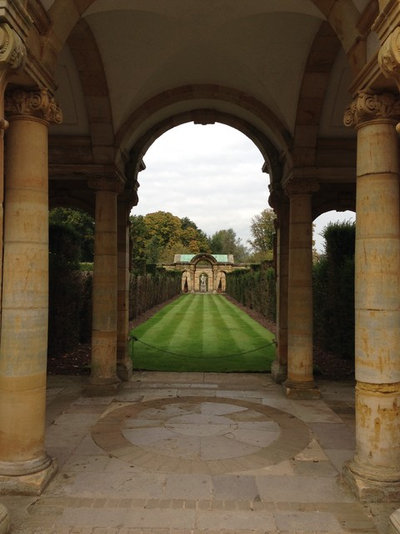 Create a strong axis.
Create a strong axis. Human control over nature is the essence of the Renaissance garden, so traditional Italian gardens have a strong structure with clear lines created by paths and layouts that are uncompromisingly symmetrical.
Many of these features were transported to the gardens of France and England, where their design in some cases was diluted, as in the Edwardian Arts and Crafts gardens, or re-created in full, as shown here at Hever Castle, in England. Hever’s Italian garden, built by William Waldorf Astor in the early 1900s, is on a grand scale. The garden is crossed by strong axes, such as the one shown, formed by long grassed allées that are viewed through pavilion archways.
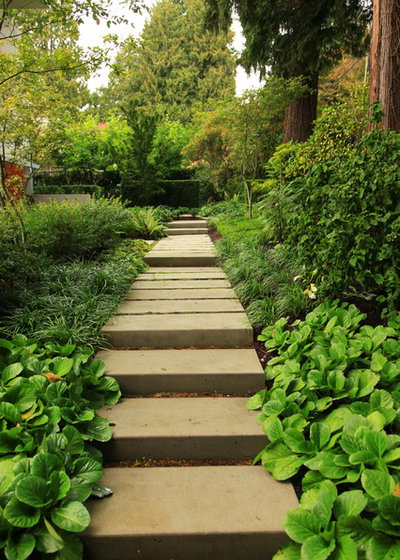
Paul Sangha Landscape Architecture
Perhaps grand allées aren’t for our smaller contemporary gardens, yet the same effect can easily be achieved with paving. This straight path creates a clear axis through the garden, softened by adjacent plantings.
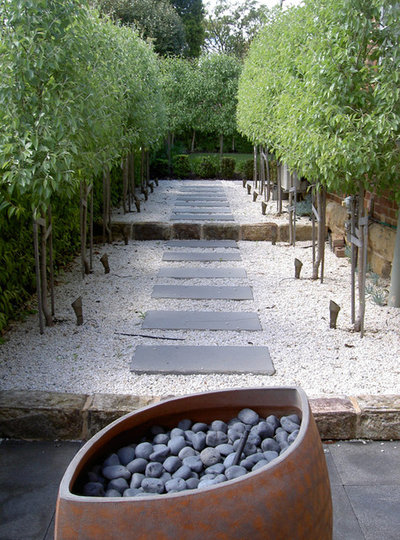
Pettet Landscapes
Even this most contemporary garden benefits from the axis in its structure. Here, trees planted evenly alongside the stepping-stone path emphasizes the straight line, leading the eye through the garden.
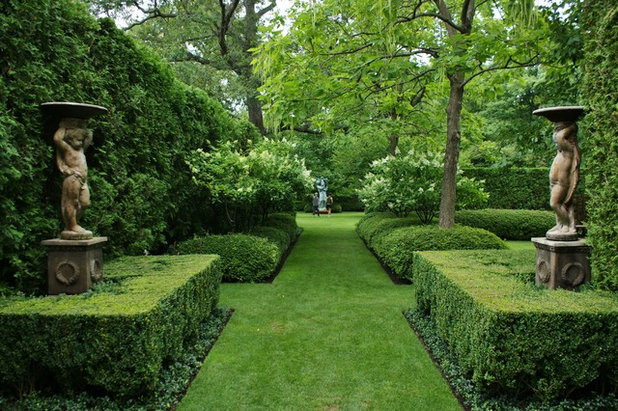
www.KarlGercens.com
Controlled shapes. As previously stated, Italian garden design is about the control of nature to create a garden that is both tranquil and elegant. To achieve this, the garden’s design must have a clear, discernible shape, be it in stairways, terraces, walls or especially in the shaping of any topiaries or hedges. Simple geometric shapes like squares and rectangles create an organized and controlled landscape, far from the wayward freedom of nature.
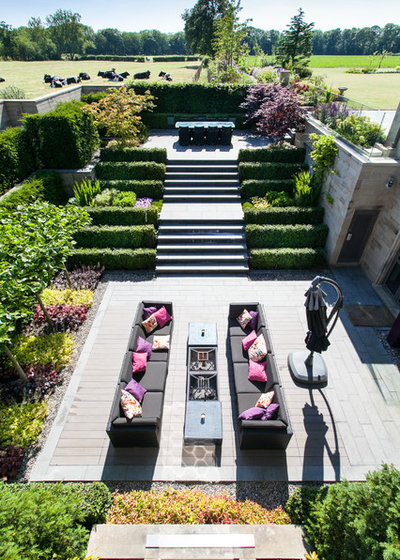
Barnes Walker Ltd - Landscape Architects
This example of a contemporary garden could be the blueprint for using controlled shapes in the design. The central axis orders each part of the design, leading right through the garden from the lower terrace up the stairs to the higher terrace. Each shape — the terrace, steps, plantings, hedges and even furniture — fits within the careful shaping of the overall design.
Many modern formal gardens have a structure within the hard landscape but the plantings may have more freedom, as in the style of Arts and Crafts gardens or the new English garden. But here we see that controlled structure is carried right through to the plantings.
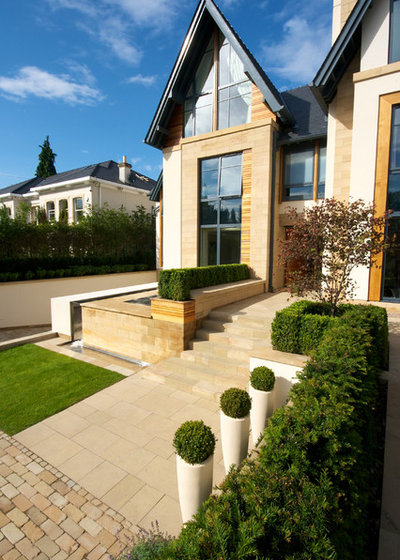
Barnes Walker Ltd - Landscape Architects
This contemporary garden has its roots in those early Italian villa gardens, with controlled shaping in every section of the design, combined with the simplicity of the plantings and strong axis lines.
Many of the great villa gardens of Italy, such as the Villa Lante, were built on hillside slopes, which not only enabled the workings of elaborate fountains and water features but also created a hard landscape of terraces and parterres linked by flights of formal stairs. It is easy then to see the link between old and new, as the steps here create the same feeling in this sloping front yard.
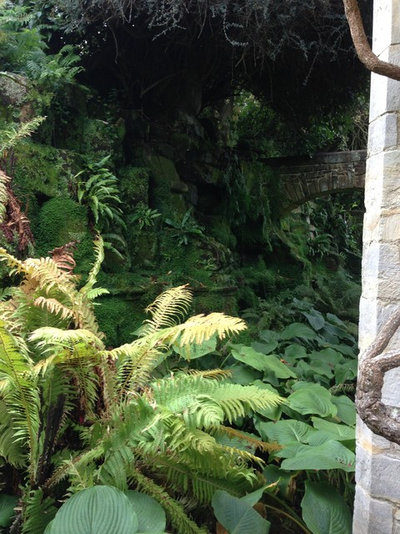 Water features.
Water features. A Renaissance Italian garden would be lost without a water feature — be it fountain, pond or grotto — designed to amuse and delight. Copies of such features can be found in both Italianate-style gardens and Arts and Crafts gardens built in the last century.
This fernery at Hever Castle was built to display an extensive fern collection. It is set in a long water rill decorated with classic statues and stonework and is viewed from the adjacent pergola walkway. The result is atmospheric — classic beauty almost overwhelmed by nature.
See how to garden with ferns
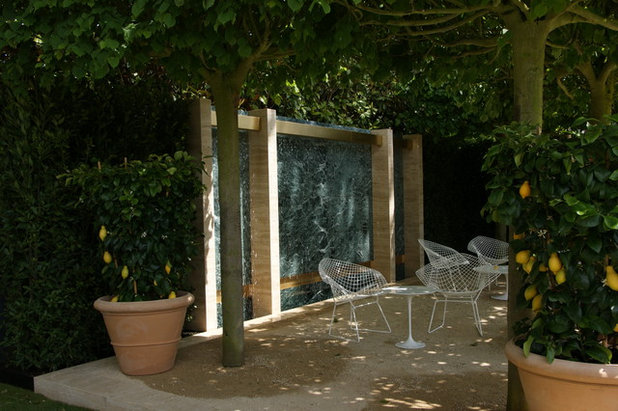
Perhaps this type of traditional grotto is not so suited to our smaller contemporary gardens. In a garden for the Chelsea Flower Show, landscape designers Tommaso del Buono and Paul Gazerwitz opted for what they called “a modern version of a grotto,” which involved water running down an 8½-foot-tall by 16-foot-wide block of gray-green, white-veined Verde Issorie marble from the Italian Alps.
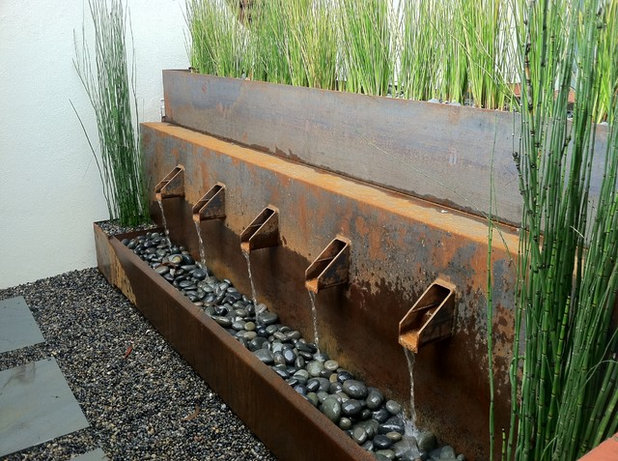
merge studio
Rills and spouts, other common features of Italianate gardens, suit our contemporary gardens. This steel and pebble water feature might not be quite as classic as or on the scale of the Hundred Fountains at the gardens of the Villa d’Este at Tivoli, where water jets spout and trickle down a wall face along the side of a 180-yard terrace into a narrow basin, but it does provide the same qualities the Renaissance gardeners were looking for: sound and movement.
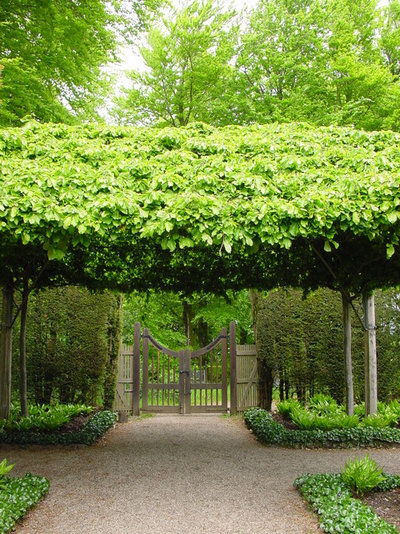 Roof-trained trees.
Roof-trained trees. Gardens in Mediterranean countries generally have shaded areas for dining and sitting to escape the midday sun. This can be achieved with a simple wood or metal pergola covered by vines, roses or other scented plants. The traditional shading method for villa gardens around Lake Maggiore and other Italian lakes is to create living parasols by training and clipping trees to form a green ceiling.
Deciduous trees, such as common lime (
Tilia x
europaea),
are used for their large leaves that provide perfect shade and for their ability to be hard pruned and shaped.
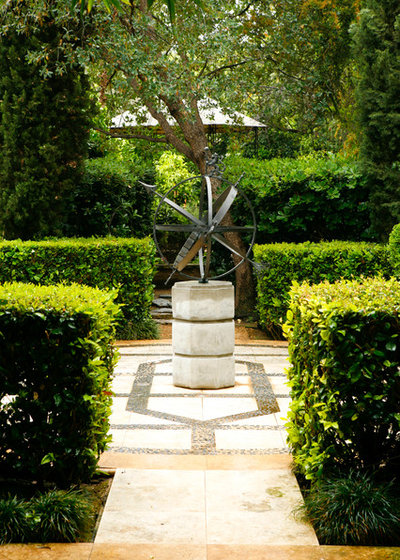
EPT DESIGN
Plantings. Clipped boxwood (
Buxus spp) used as a hedge, an edge or a topiary in the form of pyramids or spheres is the mainstay of Italian gardens. Its ability to create controlled shapes and simple, cleans lines had led to its popularity in modern gardens with an Italian touch.
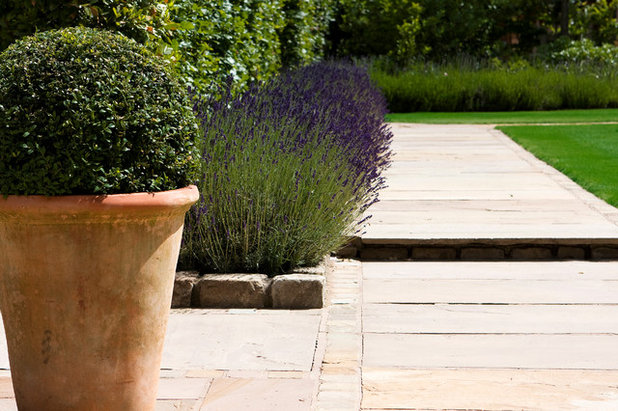
Barnes Walker Ltd - Landscape Architects
In her classic work
Italian Villas and Their Gardens (1904), Edith Wharton wrote, “The Italian garden does not exist for its flowers; its flowers exist for it: they are a late and infrequent adjunct to its beauties, a parenthetical grace counting only as one more touch in the general effect of enchantment.” This was a statement that shocked gardeners at the time, and perhaps still does. Unlike gardens of the past hundred years, Italianate gardens traditionally did not rely on the beauty of flowers for their sole interest, very similar to our contemporary gardens of today.
With its neatly clipped boxwood ball in a tall terra-cotta pot and controlled run of lavender (
Lavandula sp) along a straight paved walkway, this garden perhaps echoes Edith Wharton’s view on the understated use of flowers in Italian gardens.
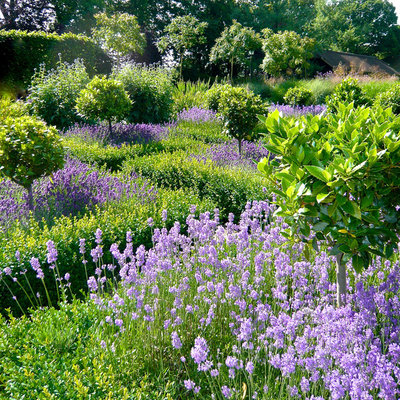
Joanne Alderson Design
This modern parterre, composed of boxwood-edged beds overflowing with lavender, echoes the historic Italian parterres. The simple geometric pattern is more akin to the early designs of Renaissance gardens than to the complicated swirling designs found later in French gardens. The center of each bed is marked by a standard Mediterranean sweet bay tree (
Laurus nobilis), a commonly used hedging plant in warmer parts of Italy but not suited to colder climes.
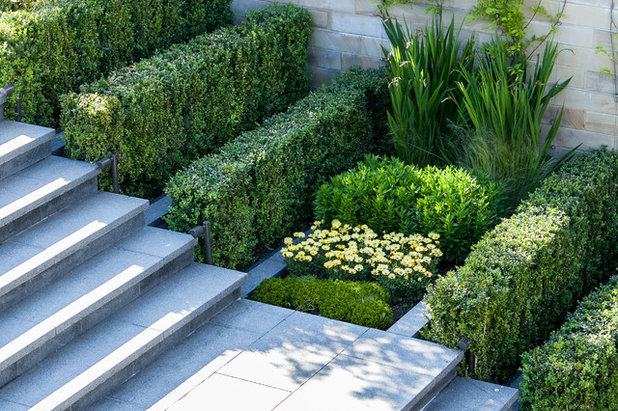
Barnes Walker Ltd - Landscape Architects
Looking closely at this planting, we can see that the garden gets its shape both from the clipped evergreen boxwoods and the perennials — including
Crocosmia, Osteospermum and
Stipa,
planted in blocks. This creates a feeling of complete control over all the planted matter.
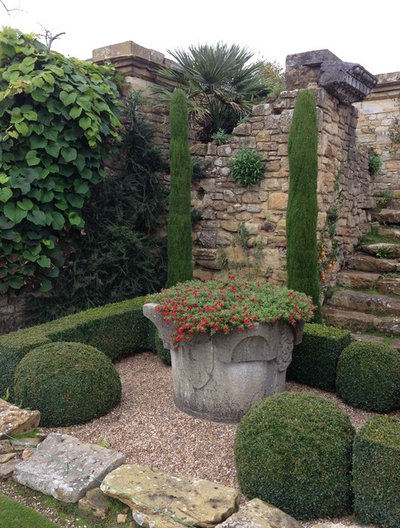
The same design ideal can be seen in this section of the Italian garden at Hever Castle. Once again the almost understated plantings are composed of both balls and rectangles of clipped boxwood with tall spires of Italian cypress (
Cupressus sempervirens). The bright red trailing, multiflowered petunias tumbling over the edge of the low stone planter provide the only flower color.
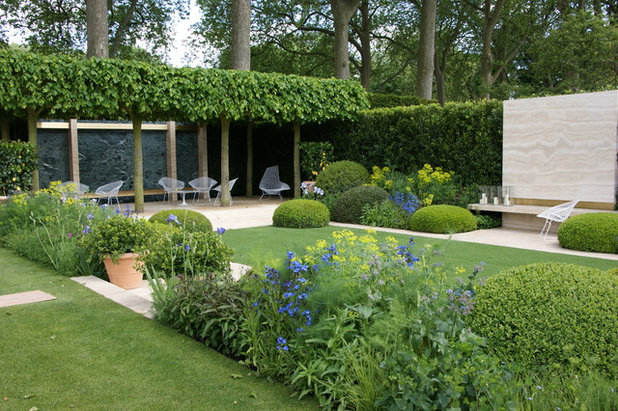
Another design for the Chelsea show, this “Italian garden for the modern era,” as the designers call it, has many design components that we can incorporate to bring a touch of the Mediterranean into our more modest gardens. These include a strong axis line, controlled shapes, a modern grotto or water feature, roof-trained trees and plants that are both appropriate and suitable for the conditions typically found in the north of Italy and similar temperate climates.
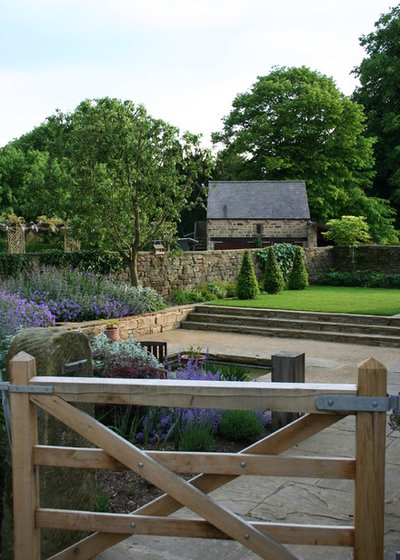
Inspired Garden Design
This modern country garden brings together many of the elements seen in the previous photo but has a totally different feel. There are controlled shapes, steps leading from a wide terrace with a formal sunken pool to a simple rectangular lawn, trimmed conifer pyramids and restrained plantings adjacent, and touches of blue almost echoing the Italian skies and Mediterranean sea.





